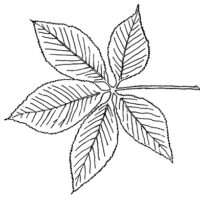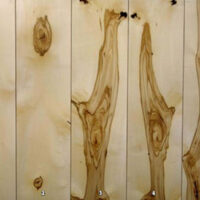 Purdue University - Extension - Forestry and Natural Resources
Purdue University - Extension - Forestry and Natural Resources
Got Nature? Blog
 The classic and trusted book “Fifty Common Trees of Indiana” by T.E. Shaw was published in 1956 as a user-friendly guide to local species. Nearly 70 years later, the publication has been updated through a joint effort by the Purdue Department of Forestry and Natural Resources, Indiana 4-H, and the Indiana Department of Natural Resources, and reintroduced as “An Introduction to Trees of Indiana.”
The classic and trusted book “Fifty Common Trees of Indiana” by T.E. Shaw was published in 1956 as a user-friendly guide to local species. Nearly 70 years later, the publication has been updated through a joint effort by the Purdue Department of Forestry and Natural Resources, Indiana 4-H, and the Indiana Department of Natural Resources, and reintroduced as “An Introduction to Trees of Indiana.”
The full publication is available for download for $7 in the Purdue Extension Education Store. The field guide helps identify common Indiana woodlot trees.
Each week, the Intro to Trees of Indiana web series will offer a sneak peek at one species from the book, paired with an ID That Tree video from Purdue Extension forester Lenny Farlee to help visualize each species as it stands in the woods. Threats to species health as well as also insight into the wood provided by the species, will be provided through additional resources as well as the Hardwoods of the Central Midwest exhibit of the Purdue Arboretum, if available.
This week, we introduce Ohio Buckeye or Aesculus glabra.
This understory tree is easily identifiable by its oppositely arranged compound leaves with five leaflets, placed like the fingers on your hand, that originate from one location on the long leaf stems. Ohio Buckeye features clusters of tubular yellow/green flowers borne on the end of the stems in the spring. In the winter, twigs show large white leaf scars where leaves were present the season prior. This tree produces round, shiny dark brown nuts, which are contained in a spiny shell.
 Ohio Buckeye is one of the first trees to leaf out in the spring, while its smooth buds also form early in the season. It is also one of the first trees to lose its leaves, typically at the end of the summer.
Ohio Buckeye is one of the first trees to leaf out in the spring, while its smooth buds also form early in the season. It is also one of the first trees to lose its leaves, typically at the end of the summer.
Ohio Buckeyes are found mostly in the understory, in the shade of other trees, on moist sites. They grow to be anywhere from 20 to 40 feet tall. According to the Morton Arboretum, Ohio Buckeyes are native from western Pennsylvania to Iowa and south to Alabama and Arkansas.
Ohio Buckeye is susceptible to a variety of pests and diseases from leaf blotch and powdery mildew to infestation by scale and Japanese beetles.
According to the Hardwoods of the Central Midwest exhibit, the sapwood is white to grayish with a darker irregular heartwood. The wood has uniformly distributed pores and its growth rings are slightly visible. With a 12 percent moisture content, buckeye weighs about 25 pounds per cubic foot, making it one of Indiana’s lightest weight woods.
The wood from Ohio Buckeye is very desirable for carving. In the past, it was used for artificial limbs. When the material is processed today, it is used for low-strength pallets and crates. It can also be used for paint grade molding.
For full article with photos view: Intro to Trees of Indiana: Ohio Buckeye
Resources:
Ohio Buckeye – Purdue Arboretum
ID That Tree Winter Edition: Opposite Leaf Arrangement – Ohio buckeye, Red maple, Purdue Extension-Forestry and Natural Resources’ YouTube playlist
Fifty Trees of the Midwest app for the iPhone
Native Trees of the Midwest, The Education Store, Purdue Extension’s resource center
Shrubs and Woody Vines of Indiana and the Midwest, The Education Store
ID That Tree, Purdue Extension-FNR’s YouTube playlist
Woodland Management Moment , Purdue Extension-FNR’s YouTube playlist
Investing in Indiana Woodlands, The Education Store
Forest Improvement Handbook, The Education Store
Wendy Mayer, FNR Communications Coordinator
Purdue University Department of Forestry and Natural Resources
Lenny Farlee, Sustaining Hardwood Extension Specialist
Purdue University Department of Forestry and Natural Resources

Recent Posts
- Report Spotted Lanternfly – Purdue Landscape Report
Posted: April 10, 2024 in Alert, Forestry, Invasive Insects, Plants, Wildlife, Woodlands - Declining Pines of the White Variety – Purdue Landscape Report
Posted: in Alert, Disease, Forestry, Plants, Wildlife, Woodlands - Are you seeing nests of our state endangered swan? – Wild Bulletin
Posted: April 9, 2024 in Alert, Forestry, How To, Wildlife - Cicadas in Spring! – Purdue Landscape Report
Posted: in Forestry, Plants, Safety, Wildlife - New Deer Impact Toolbox
Posted: April 7, 2024 in Forestry, Land Use, Plants, Publication, Safety, Wildlife, Woodlands - 2024-25 Fishing Guide now available – Wild Bulletin
Posted: April 4, 2024 in Alert, Aquaculture/Fish, Aquatic/Aquaculture Resources, How To, Ponds, Wildlife - Help Research Chronic Wasting Disease – Wild Bulletin
Posted: April 3, 2024 in Disease, Forestry, How To, Safety, Wildlife, Woodlands - Indiana Reptiles and Amphibians – IFWOA Webinar
Posted: April 1, 2024 in Forestry, How To, Webinar, Wildlife, Woodlands - Birding through the Seasons – IFWOA Webinar
Posted: in Forestry, How To, Webinar, Wildlife, Woodlands - Look Out for Invasive Carp in Your Bait Bucket – Wild Bulletin
Posted: March 31, 2024 in Alert, Aquaculture/Fish, Aquatic/Aquaculture Resources, Invasive Animal Species, Wildlife
Archives
Categories
- Alert
- Aquaculture/Fish
- Aquatic/Aquaculture Resources
- Ask the Expert
- Christmas Trees
- Community Development
- Disease
- Drought
- Forestry
- Forests and Street Trees
- Gardening
- Got Nature for Kids
- Great Lakes
- How To
- Invasive Animal Species
- Invasive Insects
- Invasive Plant Species
- Land Use
- Natural Resource Planning
- Nature of Teaching
- Plants
- Podcasts
- Ponds
- Publication
- Safety
- Timber Marketing
- Uncategorized
- Urban Forestry
- Webinar
- Wildlife
- Wood Products/Manufacturing
- Woodland Management Moment
- Woodlands